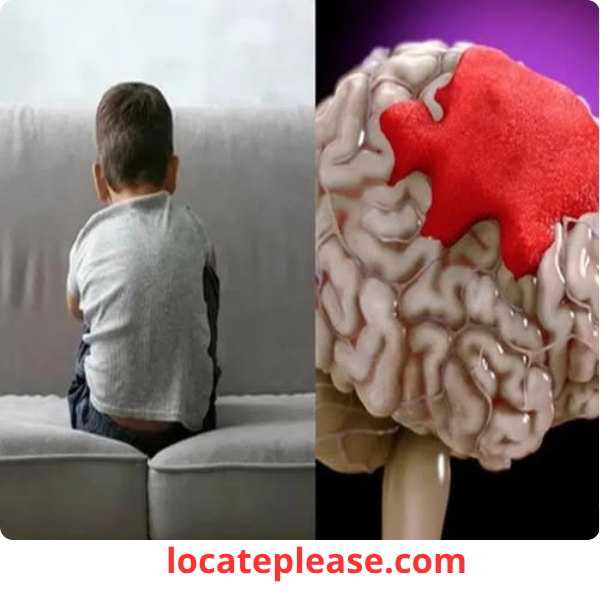When we think of stroke, we often picture elderly adults, not young children. But the heartbreaking case of a 6-year-old boy in Hubei, China, is a stark reminder: strokes can and do happen in children — even as young as six.
According to Sohu News, the boy woke up one morning complaining of a severe headache. His family assumed it was just a common cold or fatigue — nothing too serious. But within just 48 hours, his condition took a terrifying turn.
He began vomiting, his mouth twisted to one side, his eyes crossed, and one side of his body became limp and unresponsive. Alarmed, his parents rushed him to the local hospital — where doctors delivered a shocking diagnosis: an ischemic stroke.
The boy was immediately transferred to Wuhan Children’s Hospital, where scans revealed complete blockage in the blood vessels of his brain. Emergency surgery was required to restore blood flow. While he survived, his long-term recovery now depends on intensive rehabilitation and ongoing medical care.
This tragic case has sparked urgent conversations worldwide about childhood stroke — a condition many parents don’t even know exists.
Why Do Children Have Strokes?
While rare, pediatric stroke affects approximately 1 in 2,500 newborns and hundreds of older children each year. Unlike in adults, childhood strokes aren’t usually caused by high cholesterol or long-term hypertension — but by other, often overlooked factors.
Dr. Guo Qing from the Hospital of Traditional Chinese Medicine recently shared insights into four unexpected causes of stroke in children:
1. Head Injuries
Children’s brains and blood vessels are still developing — making them more vulnerable to trauma. A fall, collision, or sports injury can cause internal bleeding or blood clots that block cerebral arteries.
In this case, the boy had fallen while playing — an incident his parents didn’t think was serious at the time.
2. Infections and Inflammation
Viral or bacterial infections can trigger vasculitis — inflammation of blood vessels — which narrows arteries and increases stroke risk. Conditions like meningitis or autoimmune disorders can also be silent triggers.
3. Obesity
Overweight children are at higher risk of high blood pressure, insulin resistance, and high cholesterol — all of which damage blood vessels over time. Pediatric obesity is rising globally, and with it, the risk of early cardiovascular events.
4. Excessive Mental Stress
Yes — even children can suffer from chronic stress. Long hours of studying, pressure to perform, or excessive screen time (especially gaming) can elevate stress hormones, disrupt sleep, and strain the cardiovascular system.
Research from the University of Cambridge links chronic fatigue and stress to increased stroke risk — even in young people.
The 4 Warning Signs of Stroke in Children — Every Parent Must Know
Time is brain. The faster a stroke is treated, the better the chances of recovery.
Doctors emphasize that parents must act immediately if they notice any of these four critical signs:
1. Asymmetrical Face (Facial Drooping)
- One side of the face appears droopy or numb
- The child’s smile is crooked or lopsided
- The mouth may pull to one side
✅ Test: Ask your child to smile or puff out their cheeks.
2. Weakness or Numbness on One Side of the Body
- Inability to raise one arm or leg
- Sudden limpness or dragging of a limb
- Clumsiness or loss of coordination
✅ Test: Ask your child to raise both arms — if one drifts downward, seek help immediately.
3. Slurred Speech or Trouble Speaking
- Speech becomes slurred, unclear, or delayed
- The child may struggle to form words or repeat phrases
- May appear confused or disoriented
✅ Test: Ask your child to say a simple sentence — “The sky is blue.”
4. Blurred Vision, Vomiting, or Fainting
- Sudden vision changes (double vision, blindness in one eye)
- Severe headache with vomiting
- Dizziness, loss of balance, or loss of consciousness
These symptoms, especially when appearing suddenly, are medical emergencies.
FAST: A Simple Way to Remember Stroke Signs
Use the FAST acronym — adapted for children — to act quickly:
- Face drooping
- Arm weakness
- Speech difficulty
- Time to call emergency services
⏱️ Every minute counts. Delayed treatment can lead to permanent brain damage or death.
How to Prevent Stroke in Children
While not all strokes are preventable, parents can significantly reduce risk with proactive care:
✅ Prevent Head Injuries
- Use helmets during biking, skating, or sports.
- Childproof homes to prevent falls.
- Seek medical evaluation after any head or neck trauma — even if the child seems fine.
✅ Reduce Stress & Screen Time
- Limit gaming and academic pressure.
- Encourage breaks, outdoor play, and quality sleep.
- Watch for signs of anxiety or chronic fatigue.
✅ Promote a Healthy Diet & Active Lifestyle
- Serve plenty of fruits, vegetables, whole grains, and lean proteins.
- Limit fast food, sugary drinks, and processed snacks.
- Encourage daily physical activity — at least 60 minutes of play or exercise.
✅ Monitor Health Regularly
- Schedule routine pediatric check-ups.
- Watch for high blood pressure, heart conditions, or developmental delays.
Final Thoughts: A Wake-Up Call for Parents
The story of this 6-year-old boy is not just tragic — it’s a wake-up call.
Stroke in children is rare but real. And because symptoms are often mistaken for migraines, fatigue, or viral illness, diagnosis is frequently delayed.
By knowing the signs, understanding the risks, and acting fast, parents can be the first line of defense.
You don’t need to be a doctor to save your child’s life.
You just need to know what to look for — and when to act.
🫀 Remember: In a stroke, there is no such thing as “waiting to see.”
If something feels wrong — trust your gut.
Call for help.
And act FAST.










